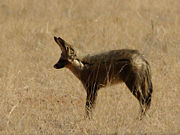Bat-eared Fox
2008/9 Schools Wikipedia Selection. Related subjects: Mammals
| Bat-eared Fox | ||||||||||||||||
|---|---|---|---|---|---|---|---|---|---|---|---|---|---|---|---|---|
 |
||||||||||||||||
| Conservation status | ||||||||||||||||
| Scientific classification | ||||||||||||||||
|
||||||||||||||||
| Binomial name | ||||||||||||||||
| Otocyon megalotis ( Desmarest, 1822) |
The Bat-eared Fox is a canid of the African savanna. It is named for its large ears. The Bat-eared Fox has tawny fur with black ears, legs and parts of the face. It averages 55 cm in length (head and body), with ears 13 cm long. It is the only species in the genus Otocyon.
The teeth of the Bat-eared Fox are much smaller than teeth of other canid species. This is an adaptation to its insectivorous diet, insects making up 80% of its food intake. the Bat-eared Fox visits termite hills, follows locust swarms or stay close to herds of zebras or antelopes in order to feed on the insects landing on their excrements. In addition to insects, the Bat-eared Fox eats rodents, birds and eggs, and sometimes fruits.
The Bat-eared Fox is mainly a nocturnal animal that lives in small groups consisting of a couple and their young. The pairs live in dens and raise the pups (two to five) together. Mated pairs are very social and are monogamous, although it is unknown if they mate for life.
Due to its unusual teeth, the Bat-eared Fox was once considered as a distinct subfamily of canids (Otocyoninae). However, according to more recent examinations, it is more closely related to the true foxes of the genus Vulpes. Other research places the genus as an outgroup which is not very closely related to foxes. The Bat-eared Fox is an old species that was widely distributed in the Pleistocene era. In that time, it even lived in parts of West and South Asia.